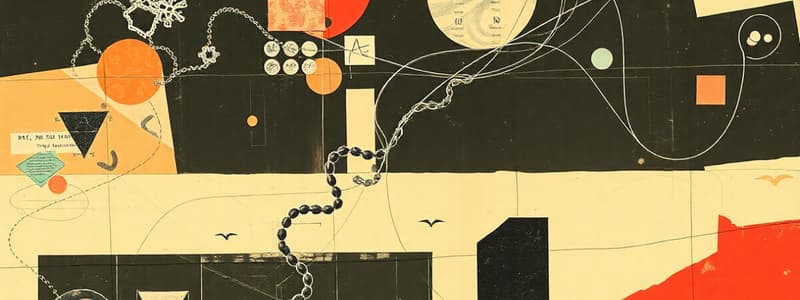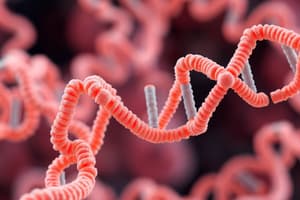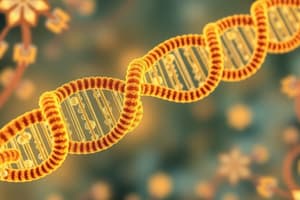Podcast
Questions and Answers
Transcription is the process of:
Transcription is the process of:
- Making a protein from a DNA template
- Making a copy of RNA from a DNA template (correct)
- Making a protein from an RNA template
- Making a copy of DNA from an RNA template
What is the role of RNA polymerase in transcription?
What is the role of RNA polymerase in transcription?
- To guide the formation of mRNA from a DNA template (correct)
- To form peptide bonds between amino acids
- To break down the DNA molecule
- To transport amino acids to the ribosome
Which of the following is NOT a step in transcription?
Which of the following is NOT a step in transcription?
- DNA unzips
- Free-floating RNA nucleotides attach to DNA bases
- mRNA molecule is released and DNA zips back up
- Amino acids are brought to the ribosome by tRNA (correct)
During transcription, what is the base pairing rule for RNA?
During transcription, what is the base pairing rule for RNA?
Where does translation take place?
Where does translation take place?
What is the function of tRNA?
What is the function of tRNA?
What is a codon?
What is a codon?
What is the function of a stop codon?
What is the function of a stop codon?
Flashcards
Protein Synthesis
Protein Synthesis
The process of creating proteins from DNA instructions; involves transcription and translation.
Transcription
Transcription
The first step in protein synthesis where DNA is converted to mRNA in the nucleus.
Translation
Translation
The second step in protein synthesis where mRNA is used to assemble amino acids into a protein at the ribosome.
mRNA
mRNA
Signup and view all the flashcards
tRNA
tRNA
Signup and view all the flashcards
Codon
Codon
Signup and view all the flashcards
Anticodon
Anticodon
Signup and view all the flashcards
Start Codon
Start Codon
Signup and view all the flashcards
Study Notes
Protein Synthesis Overview
- Protein synthesis is a two-part process: transcription and translation.
- The goal is to create a protein from a DNA template.
- Transcription occurs in the nucleus, and translation happens in the cytoplasm at ribosomes.
- If given a DNA strand, these processes will create the correct protein.
- DNA and RNA are contrasted.
Transcription
- Transcription is the creation of mRNA from a DNA template.
- This process occurs inside the nucleus.
- DNA "unzips," and RNA polymerase breaks hydrogen bonds between bases.
- Free-floating RNA nucleotides attach to the DNA bases on one side of the DNA molecule.
- Covalent bonds form between sugars and phosphates to create an mRNA strand.
- After creation of the mRNA molecule, the DNA strands "zip" back up and release the mRNA.
- RNA polymerases are enzymes that guide transcription by reading the DNA code.
RNA vs. DNA
- DNA contains thymine, RNA contains uracil.
- DNA is double-stranded, RNA is single-stranded.
- DNA contains deoxyribose, RNA contains ribose.
- One type of DNA, and three kinds of RNA (mRNA, tRNA, rRNA)
Translation
- Translation uses mRNA to make proteins.
- Translation occurs at the ribosomes.
- Anticodons on tRNA molecules are specific to certain amino acids.
- The start codon (AUG) signals the beginning of translation; producing methionine.
- Stop codons (UAA, UAG, UGA) signal the end of translation.
- Amino acids are brought to the ribosome by tRNA, and the tRNA's anticodons bind to the mRNA codons.
- Amino acids are bonded together by peptide bonds to form a polypeptide chain, a protein.
Important Processes
- mRNA takes the code from DNA for the ribosomes.
- tRNA brings amino acids to ribosomes from the cytoplasm.
- Information is transferred from DNA to RNA to proteins—the central dogma of molecular biology.
Studying That Suits You
Use AI to generate personalized quizzes and flashcards to suit your learning preferences.




